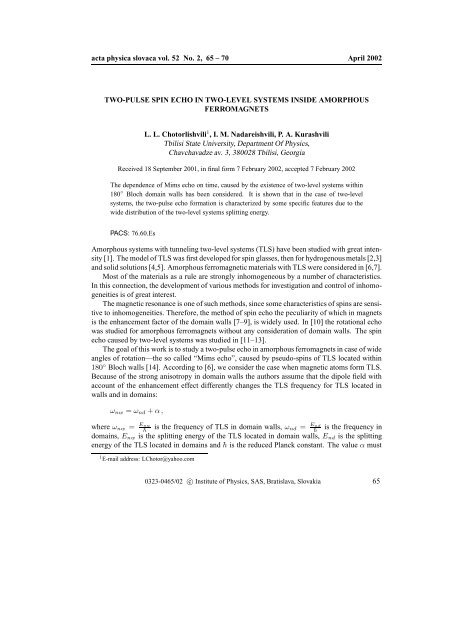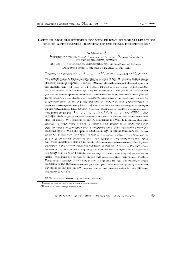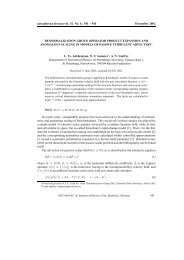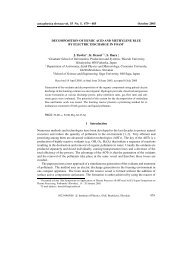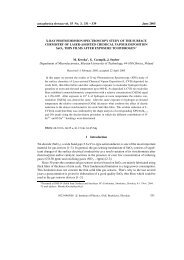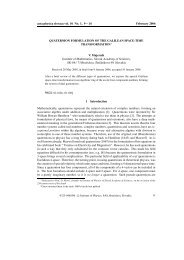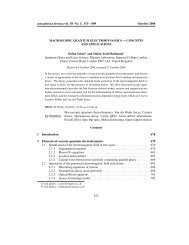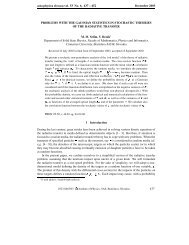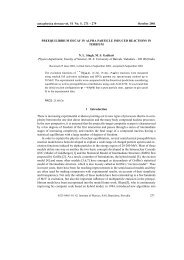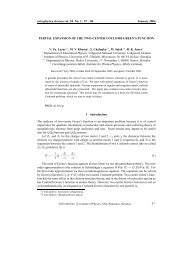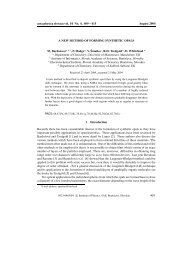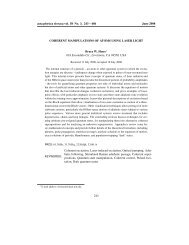Two-pulse spin echo in two-level systems inside ... - physics.sk
Two-pulse spin echo in two-level systems inside ... - physics.sk
Two-pulse spin echo in two-level systems inside ... - physics.sk
Create successful ePaper yourself
Turn your PDF publications into a flip-book with our unique Google optimized e-Paper software.
acta physica slovaca vol. 52 No. 2, 65 – 70 April 2002<br />
TWO-PULSE SPIN ECHO IN TWO-LEVEL SYSTEMS INSIDE AMORPHOUS<br />
FERROMAGNETS<br />
L. L. Chotorlishvili 1 , I. M. Nadareishvili, P. A. Kurashvili<br />
Tbilisi State University, Department Of Physics,<br />
Chavchavadze av. 3, 380028 Tbilisi, Georgia<br />
Received 18 September 2001, <strong>in</strong> f<strong>in</strong>al form 7 February 2002, accepted 7 February 2002<br />
The dependence of Mims <strong>echo</strong> on time, caused by the existence of <strong>two</strong>-<strong>level</strong> <strong>systems</strong> with<strong>in</strong><br />
180 ◦ Bloch doma<strong>in</strong> walls has been considered. It is shown that <strong>in</strong> the case of <strong>two</strong>-<strong>level</strong><br />
<strong>systems</strong>, the <strong>two</strong>-<strong>pulse</strong> <strong>echo</strong> formation is characterized by some specific features due to the<br />
wide distribution of the <strong>two</strong>-<strong>level</strong> <strong>systems</strong> splitt<strong>in</strong>g energy.<br />
PACS: 76.60.Es<br />
Amorphous <strong>systems</strong> with tunnel<strong>in</strong>g <strong>two</strong>-<strong>level</strong> <strong>systems</strong> (TLS) have been studied with great <strong>in</strong>tensity<br />
[1]. The model of TLS was first developed for <strong>sp<strong>in</strong></strong> glasses, then for hydrogenous metals [2,3]<br />
and solid solutions [4,5]. Amorphous ferromagnetic materials with TLS were considered <strong>in</strong> [6,7].<br />
Most of the materials as a rule are strongly <strong>in</strong>homogeneous by a number of characteristics.<br />
In this connection, the development of various methods for <strong>in</strong>vestigation and control of <strong>in</strong>homogeneities<br />
is of great <strong>in</strong>terest.<br />
The magnetic resonance is one of such methods, s<strong>in</strong>ce some characteristics of <strong>sp<strong>in</strong></strong>s are sensitive<br />
to <strong>in</strong>homogeneities. Therefore, the method of <strong>sp<strong>in</strong></strong> <strong>echo</strong> the peculiarity of which <strong>in</strong> magnets<br />
is the enhancement factor of the doma<strong>in</strong> walls [7–9], is widely used. In [10] the rotational <strong>echo</strong><br />
was studied for amorphous ferromagnets without any consideration of doma<strong>in</strong> walls. The <strong>sp<strong>in</strong></strong><br />
<strong>echo</strong> caused by <strong>two</strong>-<strong>level</strong> <strong>systems</strong> was studied <strong>in</strong> [11–13].<br />
The goal of this work is to study a <strong>two</strong>-<strong>pulse</strong> <strong>echo</strong> <strong>in</strong> amorphous ferromagnets <strong>in</strong> case of wide<br />
angles of rotation—the so called “Mims <strong>echo</strong>”, caused by pseudo-<strong>sp<strong>in</strong></strong>s of TLS located with<strong>in</strong><br />
180 ◦ Bloch walls [14]. Accord<strong>in</strong>g to [6], we consider the case when magnetic atoms form TLS.<br />
Because of the strong anisotropy <strong>in</strong> doma<strong>in</strong> walls the authors assume that the dipole field with<br />
account of the enhancement effect differently changes the TLS frequency for TLS located <strong>in</strong><br />
walls and <strong>in</strong> doma<strong>in</strong>s:<br />
ω nw = ω nd + α ,<br />
where ω nw = Enw<br />
¯h<br />
is the frequency of TLS <strong>in</strong> doma<strong>in</strong> walls, ω nd = E nd<br />
¯h<br />
is the frequency <strong>in</strong><br />
doma<strong>in</strong>s, E nw is the splitt<strong>in</strong>g energy of the TLS located <strong>in</strong> doma<strong>in</strong> walls, E nd is the splitt<strong>in</strong>g<br />
energy of the TLS located <strong>in</strong> doma<strong>in</strong>s and ¯h is the reduced Planck constant. The value α must<br />
1 E-mail address: LChotor@yahoo.com<br />
0323-0465/02 c○ Institute of Physics, SAS, Bratislava, Slovakia 65
66 L. L. Chotorlishvili et al.<br />
be limited by the condition γ n η 0 H 1 > |ω nd − ω nw | = α, which guarantees the TLS excitement<br />
along the whole Bloch walls. Here H 1 is the amplitude of radio frequency field, γ n is the<br />
gyromagnetic ratio for nuclei, η 0 is the value of the enhancement coefficient η(y) <strong>in</strong> the center<br />
of 180 ◦ Bloch wall. Let us expla<strong>in</strong> our assumption briefly. As it was already mentioned, we<br />
consider the case when TLS atoms are magnetic. Therefore, the matter of particular <strong>in</strong>terest<br />
for us is the dipole-dipole <strong>in</strong>teraction between the <strong>sp<strong>in</strong></strong>s of these atoms and the electron magnetic<br />
moments form<strong>in</strong>g the ferromagnetic structure of the material (doma<strong>in</strong>s and Bloch walls).<br />
The fluctuation of the dipole-dipole <strong>in</strong>teraction constant caused by atom transition between TLS<br />
states allows TLS pseudo-<strong>sp<strong>in</strong></strong> to experience the action of external magnetic field (static or variable).<br />
Let us consider that M ⃗ i = γ s ⃗s i is the magnetic moment of the atom located <strong>in</strong> i-th TLS (γ s<br />
is the gyromagnetic ratio and ⃗s i is the <strong>sp<strong>in</strong></strong> operator for electrons). The dipole-dipole <strong>in</strong>teraction<br />
H dd<br />
(<br />
= A<br />
)<br />
1 ⃗Mi ⃗<br />
rij 3 Mj between the magnetic moment M ⇀ i and electronic magnetic moments<br />
located <strong>in</strong> doma<strong>in</strong> wall changes due to the fluctuation of the <strong>in</strong>ter-atomic distance r ij caused by<br />
tunnel<strong>in</strong>g of i-th atoms from one state to another<br />
⎛ ⎛<br />
⎞<br />
A ⎜<br />
1<br />
(<br />
⎝<br />
r ij + d ) 3 ⎟ 0<br />
⎠<br />
H dd =<br />
2 ⎛<br />
⎜ 0 A ⎜<br />
1<br />
⎝<br />
⎝<br />
(<br />
r ij − d 2<br />
⎞<br />
⎞<br />
⃗M iMj ⃗ ,<br />
) 3 ⎟⎟<br />
⎠⎠<br />
where d is the distance between the states of i-th TLS, A is the dipole-dipole <strong>in</strong>teraction constant.<br />
Expression for H dd can be expanded <strong>in</strong> series <strong>in</strong> terms of the small parameter<br />
d<br />
r ij<br />
∼ 0.1.<br />
Tak<strong>in</strong>g <strong>in</strong>to account the l<strong>in</strong>ear term of this expansion we obta<strong>in</strong> the follow<strong>in</strong>g expression for the<br />
frequency of i-th TLS<br />
ω ′ i = E′ i<br />
¯h<br />
= ⎛<br />
⎝E i /¯h + 3d<br />
r<br />
∑<br />
j<br />
A ij<br />
⃗ Mi ⃗ Mj<br />
⎞<br />
⎠ d z i ,<br />
where d z i is the pseudo-<strong>sp<strong>in</strong></strong> operator of TLS, E is the splitt<strong>in</strong>g energy. When the l<strong>in</strong>e width of<br />
TLS caused by Klauder-Anderson mechanism is ∆ω ∼ 10 6 Hz, the magnitude of 3d<br />
r Aγ2 s ∼<br />
0.3 · 10 9 Hz shows that the given mechanism is effective. External magnetic field <strong>in</strong>fluences the<br />
TLS frequency by means of the <strong>in</strong>teraction with magnetic moments of electron <strong>sp<strong>in</strong></strong>s. (The direct<br />
<strong>in</strong>fluence of the external magnetic field on the magnetic moments of i-th atom, presented <strong>in</strong> the<br />
i-th TLS, does not affect the frequency of this i-th TLS. This <strong>in</strong>fluence on frequency becomes<br />
apparent <strong>in</strong> other TLS, when the magnetic moments of the given i-th TLS play the role of external<br />
electron moments.) Let us consider the <strong>in</strong>fluence of external variable field on the frequency of<br />
<strong>two</strong>-<strong>level</strong> system <strong>in</strong> detail. The variable field changes the orientation of δM electron magnetic<br />
moments. These moments take the orientation along the effective field<br />
H = H 0 + h(t) ,<br />
where H 0 is the static magnetic field and h(t) is the variable field.
<strong>Two</strong>-<strong>pulse</strong> <strong>sp<strong>in</strong></strong> <strong>echo</strong> <strong>in</strong> <strong>two</strong>-<strong>level</strong> <strong>systems</strong>. . . 67<br />
We can qualitatively estimate the change of the TLS frequency caused by this effect. Let us<br />
suppose that the variable field is <strong>in</strong> resonance with one of the packets of magnetic moments with<br />
equal quasi-Zeeman frequencies <strong>in</strong>cluded <strong>in</strong> the sum A ij M i M j . As the frequencies of M i and<br />
M j differ from each other the variable field can not be <strong>in</strong> resonance with both packets. Neglect<strong>in</strong>g<br />
the <strong>in</strong>fluence on the non-resonant moments, we can see that the above-mentioned effect is l<strong>in</strong>ear<br />
to δM<br />
δω ′ = 3d<br />
r AMδM .<br />
Let us imag<strong>in</strong>e that δM has the follow<strong>in</strong>g form δM = λh(t), where λ is the magnetic<br />
susceptibility of the electron system (the tensor of magnetic susceptibility λ αβ like the tensor<br />
of enhancement η αβ ≈ λ αβ has only one component, which is nonzero for 180 ◦ Bloch strip<br />
doma<strong>in</strong> structure). We compare <strong>two</strong> k<strong>in</strong>ds of changes when the radio-frequency field is applied.<br />
The first change of TLS frequencies δω ′ w is caused by electron <strong>sp<strong>in</strong></strong>s, exist<strong>in</strong>g <strong>in</strong> doma<strong>in</strong> walls,<br />
and the second one δω ′ α is the change caused by the <strong>sp<strong>in</strong></strong>s <strong>in</strong> doma<strong>in</strong>s. As λ w > λ α , where λ w<br />
and λ α are the magnetic susceptibilities for walls and doma<strong>in</strong>s respectively,<br />
δω ′ w<br />
δω ′ α<br />
∼ λ w<br />
λ α<br />
∼ 10 3 ,<br />
we can conclude that the <strong>in</strong>teraction of TLS with doma<strong>in</strong> walls will prevail over the <strong>in</strong>teraction<br />
with doma<strong>in</strong>s.<br />
For calculation of <strong>echo</strong> amplitude from the TLS pseudo-<strong>sp<strong>in</strong></strong> located <strong>in</strong> doma<strong>in</strong> walls, we use<br />
the method offered <strong>in</strong> [14]<br />
|∆M(ω, t)| =<br />
∣<br />
δω/2<br />
∫<br />
−δω/2<br />
d(∆ω)g w (∆ω)η(∆ω)m + (∆ω, t)<br />
, (1)<br />
∣<br />
here ∆ω = ω n − ω is the detun<strong>in</strong>g of radio-frequency field relative to the centre of passband of<br />
the receiver ω n with the width δω; g w (∆ω) is the function which takes <strong>in</strong>to account the variations<br />
of the TLS frequency <strong>in</strong> the walls, and for 180 ◦ Bloch walls has form:<br />
(<br />
g w (∆ω) = 2D dω ) −1<br />
n(y)<br />
=<br />
[4(∆ω d − ∆ω w ) −1/2 (∆ω d − ∆ω)(∆ω − ∆ω w ) 1/2] −1<br />
dy<br />
∆ω d = ω nd − ω; ∆ω w = ω nw − ω, D is the width of the walls,<br />
η(∆ω) = η 0 [(∆ω d − ∆ω)/(∆ω d − ∆ω w )] 1/2 is the enhancement coefficient. We neglect the<br />
dispersion of η 0 for the centers of the walls.<br />
Amplitude m + (∆ω, t) after the action of <strong>two</strong> <strong>pulse</strong>s is described by [15]<br />
m + (∆ω, t) = m 0 · 2α ∗ 1 β∗ 1 β2 2 exp(−i∆ω(t − 2τ 12))<br />
where τ 12 is the time <strong>in</strong>terval between the <strong>pulse</strong>s, t is the time measured from the first <strong>pulse</strong>, m 0<br />
is the equilibrium magnetization, α 1 , β 1 and β 2 are the Kelly-Kle<strong>in</strong> parameters, expressed by the<br />
<strong>pulse</strong> characteristics [15–16]:
68 L. L. Chotorlishvili et al.<br />
α 1 = cos [Ω 1 (∆ω)t 1 /2] + i cos [θ 1 (∆ω)] s<strong>in</strong> [Ω 1 (∆ω)t 1 /2] ,<br />
β 1 = s<strong>in</strong> [θ 1 (∆ω)] s<strong>in</strong> [Ω 1 (∆ω)t 1 /2] ,<br />
β 2 = s<strong>in</strong> [θ 2 (∆ω)] s<strong>in</strong> [Ω 2 (∆ω)t 2 /2] ,<br />
[<br />
Ω 1,2 (∆ω) = γnη 2 2 (∆ω)(h (1,2) ) 2 + ∆ω 2] 1/2<br />
,<br />
tn[θ 1,2 (∆ω)] = γ n h (1,2) η(∆ω)/∆ω .<br />
Here h (1,2) is the radio-frequency field amplitude, t 1 and t 2 denote the duration of radiofrequency<br />
field.<br />
When we have wide angles of rotation (Ω 1,2 t 1,2 >> 2π) for the same radio-frequency<br />
<strong>pulse</strong>s, the <strong>in</strong>tegration by ∆ω removes fast oscillat<strong>in</strong>g factors s<strong>in</strong> Ωt and cos Ωt down to zero.<br />
Therefore, the formula (1) takes the simplest form:<br />
|∆M(ω, t)| = 3m δω/2<br />
∫<br />
0<br />
16 ∣ d(∆ω)(ω nd − ω nw ) −1/2 (∆ω d − ∆ω) −1 (∆ω − ∆ω w ) −1/2 ·<br />
−δω/2<br />
(2)<br />
· ∆ωη 4 (∆ω)(γ n h) 3[ ∆ω 2 + (γ n η(∆ω)h) 2] 2 exp [−i∆ω(t − 2τ12 )]<br />
∣ .<br />
The peculiarity of TLS is the dispersion of splitt<strong>in</strong>g energy E requir<strong>in</strong>g the obta<strong>in</strong>ed expression<br />
to be averaged by distribution function. The further simplification of (2) also depends on<br />
E. When E/¯h ∼ ω n where ω n is the carrier frequency of the receiver, δω >> γ n hη(∆ω) is<br />
valid δω is the TLS l<strong>in</strong>e shape width caused by Klauder-Anderson mechanism [17], equals to the<br />
passband width of the receiver). In this case the expression<br />
∆ω exp [−i∆ω(t − 2τ 1,2 )] ÷ [ ∆ω 2 + (γ n hη(∆ω)) 2] 2<br />
is the fast-oscillat<strong>in</strong>g factor under the <strong>in</strong>tegral (2). Therefore, for ∆ω = 0 other factors can<br />
be removed from under the sign of the <strong>in</strong>tegral and thereafter the limits of <strong>in</strong>tegration tend to<br />
<strong>in</strong>f<strong>in</strong>ity. As a result, tak<strong>in</strong>g <strong>in</strong>to account the averag<strong>in</strong>g by the TLS distribution function, we have<br />
¯p<br />
E∫<br />
max<br />
∫ E<br />
E=0 ∆ 0=0<br />
EdEd∆ 0<br />
∆ 0<br />
√<br />
E2 − ∆ 2 0<br />
,<br />
here ¯p is the TLS state density and ∆ 0 is the TLS tunnel<strong>in</strong>g parameter. For the resonant TLS, the<br />
energy of which is with<strong>in</strong> the <strong>in</strong>terval ¯hω n − ¯hδω < E < ¯hω n + ¯hδω, we have<br />
|M(ω, t)| ∼ ¯p<br />
¯hω n+¯hδω ∫<br />
∫ E<br />
¯hω n−¯hδω ∆ 0=0<br />
√ ∣∣∣∣<br />
E/¯h − ω n<br />
E/¯h − ω<br />
∣ |t − 2τ 12| exp<br />
[− (|E/¯h − ω n|) 1/2 ]<br />
EdEd∆ 0<br />
√<br />
|t − 2τ 12 | ∆ 0 E2 − ∆ 2 0<br />
(3)
<strong>Two</strong>-<strong>pulse</strong> <strong>sp<strong>in</strong></strong> <strong>echo</strong> <strong>in</strong> <strong>two</strong>-<strong>level</strong> <strong>systems</strong>. . . 69<br />
Fig. 1. Echo signal dependence on time.<br />
In the opposite case δω
70 L. L. Chotorlishvili et al.<br />
Fig. 2. Echo amplitude dependence on rf field frequency. The solid l<strong>in</strong>e corresponds to nuclear <strong>sp<strong>in</strong></strong>s is<br />
taken from [14]. The dashed l<strong>in</strong>e corresponds to TLS.<br />
References<br />
[1] W. A. Phillips: J. Low. Temp. Phys. 7 (1972) 351<br />
[2] H. Wipf, K. Neumaier: Phys. Rev. Lett. 52 (1984) 1308<br />
[3] H. Wipf: Phys. Rev. Lett. 46 (1981) 947<br />
[4] F. S. Vagapova, R. S. Saburova: Optics and spectroscopy 143 (1997) 474<br />
[5] F. S. Vagapova, R. S. Saburova: The news of vuses 7 (1993) 49<br />
[6] S. V. Maleev, Y. N. Skryab<strong>in</strong>: JETP 83 (1982) 79<br />
[7] M. M. Akhalkatsi, G. I. Mamniashvili: PMM 81 (1996) 79<br />
[8] I. G. Kiliptari: Phys. Rev. B 52 (1995) 7346<br />
[9] I. G. Kiliptari, V. I. Tsifr<strong>in</strong>ovich: Phys. Rev. 57 (1998) 11554<br />
[10] L. L. Chotorlishvili: Low. Temp. Phys. 26 (2000) 62<br />
L. L. Chotorlishvili: Low. Temp. Phys. 27 (2001) 511<br />
[11] C. Enss: Phys. Rev. B 51 (1995) 811<br />
[12] R. Weis, C. Enss, S. Hunkl<strong>in</strong>ger: Phys. Rev. Lett. 75 (1995) 2220<br />
[13] C. Enss, S. Hunkl<strong>in</strong>ger: Proc. of the 21 st Int. Conf. on Low. Temp. Phys. Czech. J. of Phys. 46 Suppl.<br />
S6 (1996) 3287<br />
[14] W. B. Mims: Phys. Rev. 120 (1966) 681<br />
M. I. Kurk<strong>in</strong>, E. A. Turov: NMR <strong>in</strong> Magnetically ordered Materials And Its Applications (<strong>in</strong> Russian)<br />
Nauka, Moscow, 1990<br />
[15] A. L. Bloom: Phys. Rev. 98 (1955) 1105<br />
[16] E. T. Ja<strong>in</strong>es: Phys. Rev. 120 (1955) 1099<br />
[17] L. L. Buishvili, L. J. Zakharov, A. I. Tugushi: TMP 96 (1993) 453


